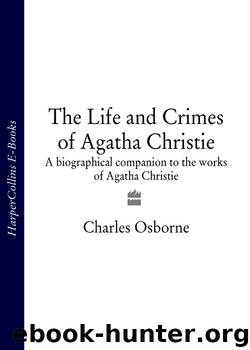The Life and Crimes of Agatha Christie by Charles Osborne

Author:Charles Osborne [Osborne, Charles]
Language: eng
Format: epub
ISBN: 9780007455508
Publisher: HarperCollins Publishers
Published: 2000-03-13T16:00:00+00:00
Within months, the war in Europe was over.
Professionally, as well as personally, 1945 had been a happy year for Agatha Christie. She had seen two of her plays produced – Appointment with Death and Murder on the Nile – and had published two novels, Death Comes as the End and Sparkling Cyanide.
It was a friend of the Mallowans, Professor Stephen Glanville, who, over dinner one evening in 1943, persuaded Agatha Christie to write a crime novel set, not in the England of 1943, but in the Egypt of four thousand years earlier. Glanville thought that such a novel would be of interest both to the crime fiction enthusiast and to readers interested in ancient times. Agatha claimed that she was too ignorant on the subject of Egypt in the time of the Pharaohs, but by the end of an evening of argument Glanville had virtually convinced her that she could do it. ‘You’ve read a lot of Egyptology,’ he said. ‘You are not only interested in Mesopotamia.’ This was true: one of her favourite books was The Dawn of Conscience by the American historian James Henry Breasted, an authority on ancient Egyptian history, and she had read widely in the field of Egyptology a few years earlier when she was writing her play, Akhnaton. When Glanville drew her attention to certain incidents in Egyptian history, and thrust half a dozen or more books upon her, Agatha realized that the die was cast.
The ‘recently published letters’ on which Death Comes as the End was based were the Henanakhte Papers, letters from a farmer which had been discovered in a rock tomb opposite Luxor in 1920–21 by the Egyptian Expedition of the Metropolitan Museum of Art. During the writing of the book, Agatha Christie found it necessary to bombard Stephen Glanville with questions, most of which he managed to answer although many of the queries involved him in hours of research. What did the Egyptians eat? How was their meat cooked? Were there special dishes for certain feasts? Did the men and women eat together? What were their sleeping arrangements? Did they eat at a table, or on the floor? Did the women occupy a separate part of the house? Did they keep linen in chests or in cupboards? What kind of houses did they have? Houses were far more difficult to find out about than temples or palaces, for many of the temples remain, whereas domestic buildings were made of less durable material than stone and have not survived.
Glanville read and commented upon the typescript, chapter by chapter. He objected to an important passage in the dénouement, and argued his case so strongly that the author finally gave in to him, and altered it against, as she continued to maintain, her better judgment. Her own ending would have been more dramatic, and, when she came to write her autobiography twenty years or more later, she noted: ‘I still think now, when I re-read the book, that I would like to rewrite
Download
This site does not store any files on its server. We only index and link to content provided by other sites. Please contact the content providers to delete copyright contents if any and email us, we'll remove relevant links or contents immediately.
4 3 2 1: A Novel by Paul Auster(12283)
The handmaid's tale by Margaret Atwood(7679)
Giovanni's Room by James Baldwin(7191)
Asking the Right Questions: A Guide to Critical Thinking by M. Neil Browne & Stuart M. Keeley(5633)
Big Magic: Creative Living Beyond Fear by Elizabeth Gilbert(5610)
Ego Is the Enemy by Ryan Holiday(5294)
The Body: A Guide for Occupants by Bill Bryson(4974)
On Writing A Memoir of the Craft by Stephen King(4863)
Ken Follett - World without end by Ken Follett(4645)
Adulting by Kelly Williams Brown(4487)
Bluets by Maggie Nelson(4473)
Eat That Frog! by Brian Tracy(4435)
Guilty Pleasures by Laurell K Hamilton(4360)
The Poetry of Pablo Neruda by Pablo Neruda(4039)
Alive: The Story of the Andes Survivors by Piers Paul Read(3968)
White Noise - A Novel by Don DeLillo(3954)
Fingerprints of the Gods by Graham Hancock(3940)
The Book of Joy by Dalai Lama(3899)
The Bookshop by Penelope Fitzgerald(3775)
